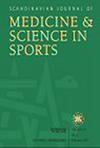优秀短跑运动员和跳远运动员与娱乐性运动控制组之间腘绳肌腱单位几何形状和功能的差异。
IF 3.8
2区 医学
Q1 SPORT SCIENCES
引用次数: 0
摘要
腿筋对运动表现至关重要;然而,没有研究检验过优秀短跑运动员/跳远运动员和休闲活动者在腿筋几何形状(横截面积/体积)和肌肉类型(I/II型纤维的比例)方面的差异。本研究旨在比较这些组之间的腿筋几何形状和类型,并研究这些特征与短跑和力量表现的关系。优秀短跑和跳远运动员(n = 15, 3名女性,21.7±2.2 y, 180.6±9.9 cm, 72.2±9.6 kg)和休闲活动者(n = 15, 4名女性,25.7±3.0 y, 176.0±9.5 cm, 76.3±17.6 kg)完成了短跑和偏心膝屈肌力量测试。分别使用磁共振成像和光谱学来评估腘绳肌肌腱的几何形状和类型。与娱乐活动的个体相比,优秀运动员的腘绳肌更大(所有肌肉,平均差异:59.75 ~ 150.45 cm3, p < 0.001),股二头肌长头(BFlh)近端腱膜(1.09 cm3, p < 0.001), BF短头远端腱膜(1.24 cm3, p = 0.002),半膜肌近端自由肌腱(0.75 cm3, p = 0.024)和腱膜(2.29 cm3, p < 0.001),半腱肌远端自由肌腱(0.49 cm3, p = 0.01)和BFlh近端腱膜界面区(10.43 cm2, p < 0.001)。优秀运动员的II型纤维估计比例也高出1.5倍(p < 0.001)。内侧腿筋几何形状和肌肉类型解释了最大冲刺速度的最大差异(R2 = 0.65),而BFlh和半膜肌体积与半腱肌体积解释了偏心膝屈肌力量的最大差异(R2 = 0.59)。优秀运动员的腘绳肌、腱膜和游离肌腱更大,II型纤维的估计比例也比娱乐活动的人高。这些结构和成分上的差异很可能促成了它们卓越的冲刺和力量表现。本文章由计算机程序翻译,如有差异,请以英文原文为准。
Differences in Hamstring Muscle-Tendon Unit Geometry and Function Between Elite Sprint and Jump Athletes and Recreationally Active Controls.
The hamstrings are critical for athletic performance; however, no study has examined differences in hamstring muscle-tendon geometry (cross-sectional area/volume) and muscle typology (proportion of Type I/II fibers) between elite sprinters/jumpers and recreationally active individuals. This study aimed to compare hamstring geometry and typology between these groups and examine how these characteristics relate to sprint and strength performance. Elite sprint and jump athletes (n = 15, 3 female, 21.7 ± 2.2 y, 180.6 ± 9.9 cm, 72.2 ± 9.6 kg) and recreationally active individuals (n = 15, 4 female, 25.7 ± 3.0 y, 176.0 ± 9.5 cm, 76.3 ± 17.6 kg) completed sprint and eccentric knee flexor strength testing. Magnetic resonance imaging and spectroscopy were used to assess hamstring muscle-tendon geometry and typology, respectively. Compared to recreationally active individuals, elite athletes had larger hamstring muscles (all muscles, mean difference: 59.75-150.45 cm3, p < 0.009), biceps femoris long head (BFlh) proximal aponeuroses (1.09 cm3, p < 0.001), BF short head distal aponeuroses (1.24 cm3, p = 0.002), semimembranosus proximal free tendons (0.75 cm3, p = 0.024) and aponeuroses (2.29 cm3, p < 0.001), semitendinosus distal free tendons (0.49 cm3, p = 0.01) and BFlh proximal aponeurosis interface areas (10.43 cm2, p < 0.001). Elite athletes also had 1.5 times greater estimated proportion of Type II fibers (p < 0.001). Medial hamstring geometry and muscle typology explained the greatest variance in maximal sprint speed (R2 = 0.65), while BFlh and semimembranosus muscle volumes with semitendinosus tendon volume explained the greatest variance in eccentric knee flexor strength (R2 = 0.59). Elite athletes had larger hamstring muscles, aponeuroses, and free tendons, and a greater estimated proportion of Type II fibers than recreationally active individuals. These structural and compositional differences likely contribute to their superior sprint and strength performance.
求助全文
通过发布文献求助,成功后即可免费获取论文全文。
去求助
来源期刊
CiteScore
7.90
自引率
4.90%
发文量
162
审稿时长
3 months
期刊介绍:
The Scandinavian Journal of Medicine & Science in Sports is a multidisciplinary journal published 12 times per year under the auspices of the Scandinavian Foundation of Medicine and Science in Sports.
It aims to publish high quality and impactful articles in the fields of orthopaedics, rehabilitation and sports medicine, exercise physiology and biochemistry, biomechanics and motor control, health and disease relating to sport, exercise and physical activity, as well as on the social and behavioural aspects of sport and exercise.

 求助内容:
求助内容: 应助结果提醒方式:
应助结果提醒方式:


